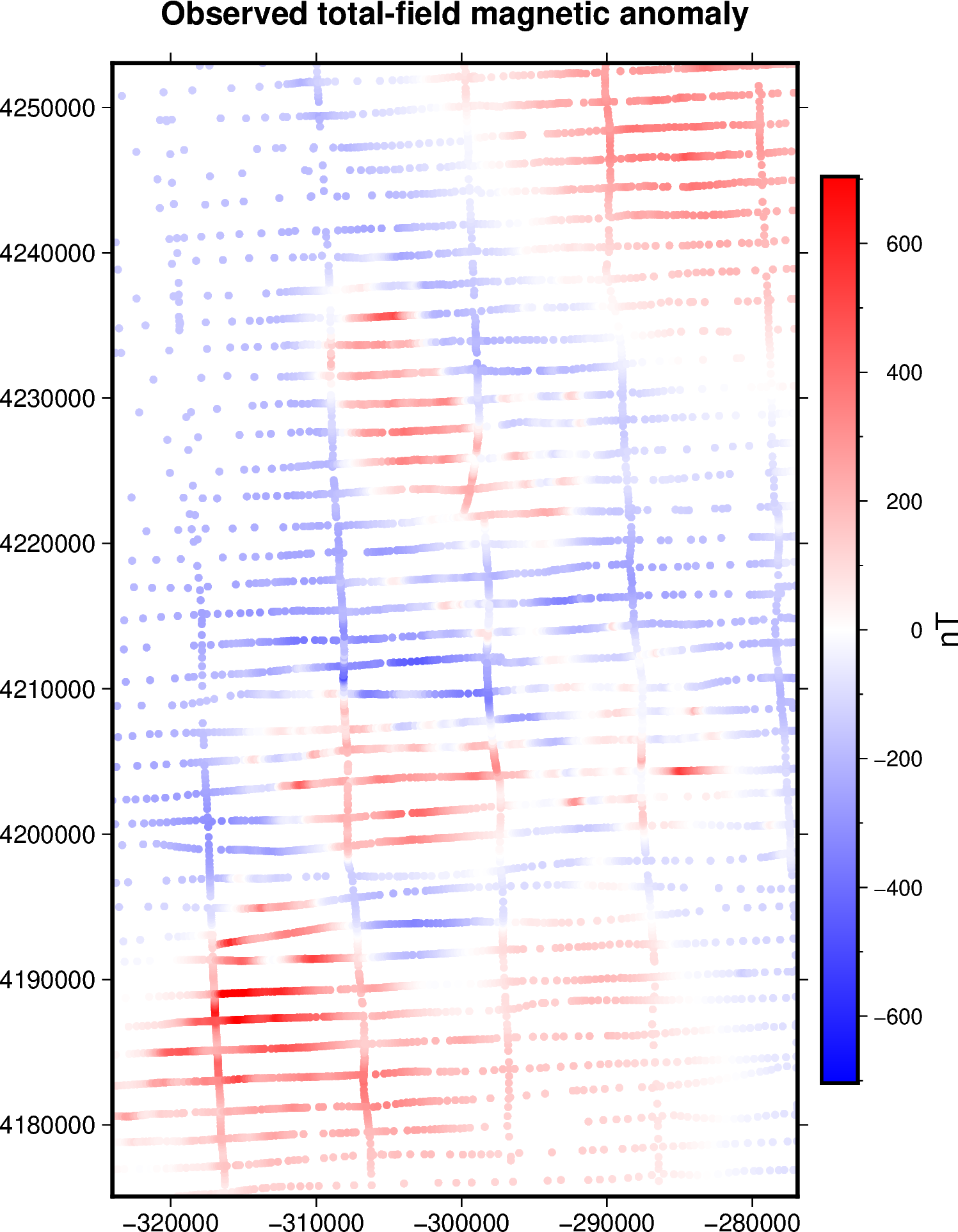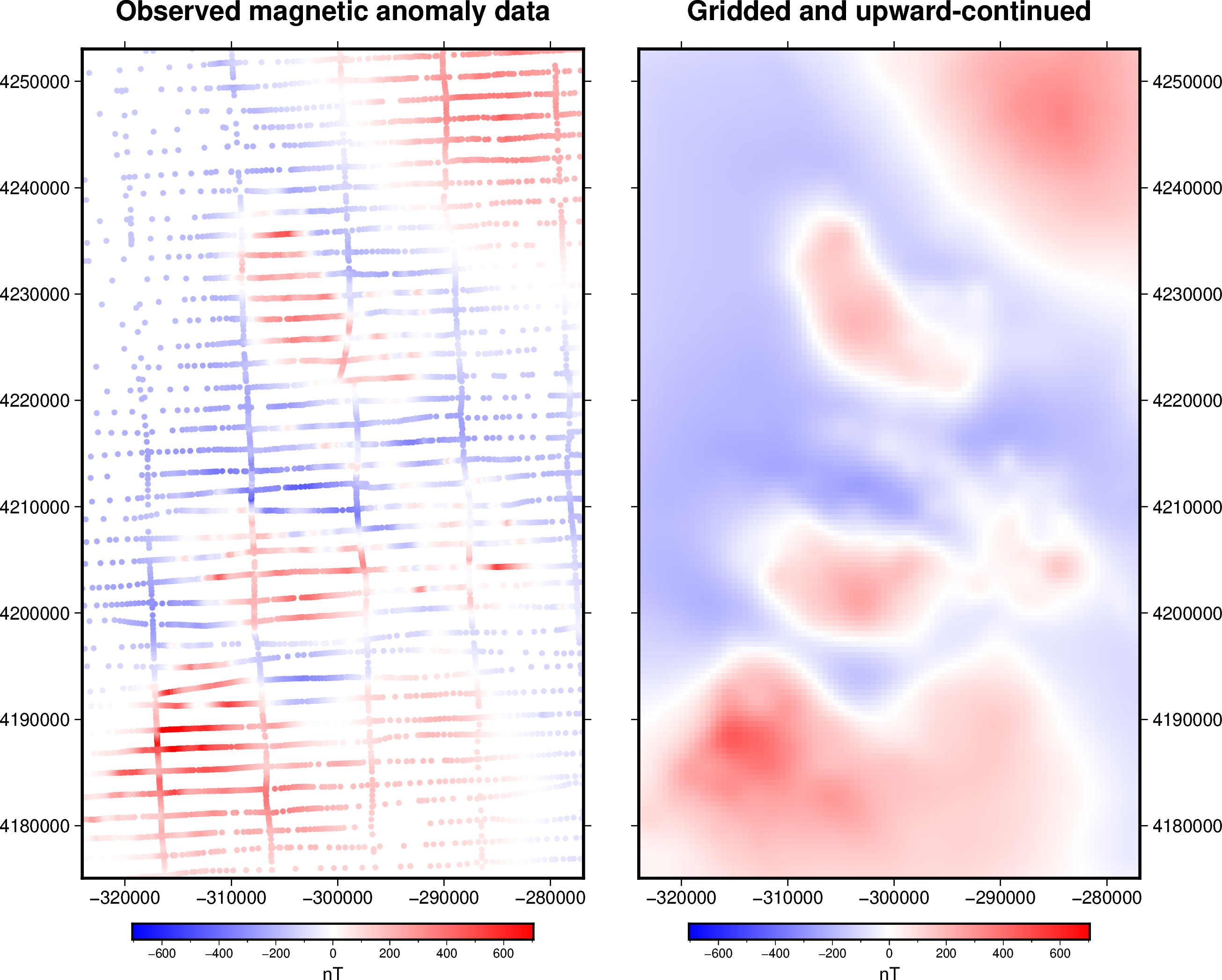Block-averaged equivalent sources#
When we introduced the Equivalent Sources we saw that
by default the harmonica.EquivalentSources class locates one point
source beneath each data point during the fitting process, following
[Cordell1992].
Alternatively, we can use another strategy: the block-averaged sources, introduced in [Soler2021]. This method divides the survey region (defined by the data) into square blocks of equal size, computes the median coordinates of the data points that fall inside each block and locates one source beneath every averaged position. This way, we define one equivalent source per block, with the exception of empty blocks that won’t get any source.
This method has two main benefits:
It lowers the amount of sources involved in the interpolation, therefore it reduces the computer memory requirements and the computation time of the fitting and prediction processes.
It might avoid to produce aliasing on the output grids, specially for surveys with oversampling along a particular direction, like airborne ones.
We can make use of the block-averaged sources within the
harmonica.EquivalentSources class by passing a value to the
block_size parameter, which controls the size of the blocks.
Lets load some total-field magnetic data over Great Britain:
import ensaio
import pandas as pd
fname = ensaio.fetch_britain_magnetic(version=1)
data = pd.read_csv(fname)
data
| line_and_segment | year | longitude | latitude | height_m | total_field_anomaly_nt | |
|---|---|---|---|---|---|---|
| 0 | FL1-1 | 1955 | -1.74162 | 53.48164 | 792 | 62 |
| 1 | FL1-1 | 1955 | -1.70122 | 53.48352 | 663 | 56 |
| 2 | FL1-1 | 1955 | -1.08051 | 53.47677 | 315 | 30 |
| 3 | FL1-1 | 1955 | -1.07471 | 53.47672 | 315 | 31 |
| 4 | FL1-1 | 1955 | -1.01763 | 53.47586 | 321 | 44 |
| ... | ... | ... | ... | ... | ... | ... |
| 541503 | FL-3(TL10-24)-1 | 1965 | -4.68843 | 58.26786 | 1031 | 64 |
| 541504 | FL-3(TL10-24)-1 | 1965 | -4.68650 | 58.26786 | 1045 | 74 |
| 541505 | FL-3(TL10-24)-1 | 1965 | -4.68535 | 58.26790 | 1035 | 94 |
| 541506 | FL-3(TL10-24)-1 | 1965 | -4.68419 | 58.26787 | 1024 | 114 |
| 541507 | FL-3(TL10-24)-1 | 1965 | -4.68274 | 58.26790 | 1011 | 120 |
541508 rows × 6 columns
In order to speed-up calculations we are going to slice a smaller portion of the data:
import verde as vd
region = (-5.5, -4.7, 57.8, 58.5)
inside = vd.inside((data.longitude, data.latitude), region)
data = data[inside]
data
| line_and_segment | year | longitude | latitude | height_m | total_field_anomaly_nt | |
|---|---|---|---|---|---|---|
| 383858 | FL-47-2 | 1964 | -5.38345 | 57.95592 | 305 | 112 |
| 383859 | FL-47-2 | 1964 | -5.38180 | 57.95614 | 305 | 120 |
| 383860 | FL-47-2 | 1964 | -5.38011 | 57.95633 | 305 | 150 |
| 383861 | FL-47-2 | 1964 | -5.37851 | 57.95658 | 305 | 170 |
| 383862 | FL-47-2 | 1964 | -5.37650 | 57.95693 | 305 | 220 |
| ... | ... | ... | ... | ... | ... | ... |
| 538970 | FL-16(TL24-36)-6 | 1965 | -4.70304 | 58.49978 | 319 | 162 |
| 541490 | FL-11-5 | 1965 | -4.88674 | 58.40691 | 1056 | 245 |
| 541491 | FL-11-5 | 1965 | -4.88377 | 58.40689 | 1069 | 250 |
| 541492 | FL-11-5 | 1965 | -4.88202 | 58.40724 | 1055 | 245 |
| 541493 | FL-11-5 | 1965 | -4.88047 | 58.40728 | 1041 | 234 |
7054 rows × 6 columns
And project the geographic coordinates to plain Cartesian ones:
import pyproj
projection = pyproj.Proj(proj="merc", lat_ts=data.latitude.mean())
easting, northing = projection(data.longitude.values, data.latitude.values)
coordinates = (easting, northing, data.height_m)
xy_region=vd.get_region(coordinates)
import pygmt
maxabs = vd.maxabs(data.total_field_anomaly_nt)*.8
# Set figure properties
w, e, s, n = xy_region
fig_height = 15
fig_width = fig_height * (e - w) / (n - s)
fig_ratio = (n - s) / (fig_height / 100)
fig_proj = f"x1:{fig_ratio}"
# Plot original magnetic anomaly and the gridded and upward-continued version
fig = pygmt.Figure()
title = "Observed total-field magnetic anomaly"
pygmt.makecpt(
cmap="polar+h0",
series=(-maxabs, maxabs),
background=True,
)
with pygmt.config(FONT_TITLE="12p"):
fig.plot(
projection=fig_proj,
region=xy_region,
frame=[f"WSne+t{title}", "xa10000", "ya10000"],
x=easting,
y=northing,
fill=data.total_field_anomaly_nt,
style="c0.1c",
cmap=True,
)
fig.colorbar(cmap=True, position="JMR", frame=["a200f100", "x+lnT"])
fig.show()

Most airborne surveys like this one present an anysotropic distribution of the data: there are more observation points along the flight lines that goes west to east than the ones going south to north. Placing a single source beneath each observation point generates an anysotropic distribution of the equivalent sources, which might lead to aliases on the generated outputs.
Instead, we can use the block-averaged equivalent sources by
creating a harmonica.EquivalentSources instance passing the size of
the blocks through the block_size parameter.
import harmonica as hm
eqs = hm.EquivalentSources(depth=1000, damping=1, block_size=500)
These sources were set at a depth of 1km below the average height of the data
points inside each block. The damping is equal to 1 to avoid overfitting
the data. See how you can choose values for these parameters in
Estimating damping and depth parameters.
Important
We recommend using a block_size not larger than the desired resolution
of the interpolation grid.
Now we can fit the equivalent sources against the magnetic data. During this step the point sources are created through the block averaging process.
eqs.fit(coordinates, data.total_field_anomaly_nt)
EquivalentSources(block_size=500, damping=1, depth=1000)In a Jupyter environment, please rerun this cell to show the HTML representation or trust the notebook.
On GitHub, the HTML representation is unable to render, please try loading this page with nbviewer.org.
EquivalentSources(block_size=500, damping=1, depth=1000)
Tip
We can obtain the coordinates of the created sources through the points_
attribute. Lets see how many sources it created:
eqs.points_[0].size
3368
We have less sources than observation points indeed.
We can finally grid the magnetic data using the block-averaged equivalent sources. We will generate a regular grid with a resolution of 500 m and at 1500 m height. Since the maximum height of the observation points is around 1000 m we are efectivelly upward continuing the data.
grid_coords = vd.grid_coordinates(
region=vd.get_region(coordinates),
spacing=500,
extra_coords=1500,
)
grid = eqs.grid(grid_coords, data_names=["magnetic_anomaly"])
grid
<xarray.Dataset> Size: 241kB
Dimensions: (northing: 157, easting: 95)
Coordinates:
* easting (easting) float64 760B -3.24e+05 -3.235e+05 ... -2.769e+05
* northing (northing) float64 1kB 4.175e+06 4.176e+06 ... 4.253e+06
upward (northing, easting) float64 119kB 1.5e+03 ... 1.5e+03
Data variables:
magnetic_anomaly (northing, easting) float64 119kB 30.31 30.5 ... 151.0
Attributes:
metadata: Generated by EquivalentSources(block_size=500, damping=1, dept...fig = pygmt.Figure()
title = "Observed magnetic anomaly data"
pygmt.makecpt(
cmap="polar+h0",
series=(-maxabs, maxabs),
background=True)
with pygmt.config(FONT_TITLE="14p"):
fig.plot(
projection=fig_proj,
region=xy_region,
frame=[f"WSne+t{title}", "xa10000", "ya10000"],
x=easting,
y=northing,
fill=data.total_field_anomaly_nt,
style="c0.1c",
cmap=True,
)
fig.colorbar(cmap=True, frame=["a200f100", "x+lnT"])
fig.shift_origin(xshift=fig_width + 1)
title = "Gridded and upward-continued"
with pygmt.config(FONT_TITLE="14p"):
fig.grdimage(
frame=[f"ESnw+t{title}", "xa10000", "ya10000"],
grid=grid.magnetic_anomaly,
cmap=True,
)
fig.colorbar(cmap=True, frame=["a200f100", "x+lnT"])
fig.show()
